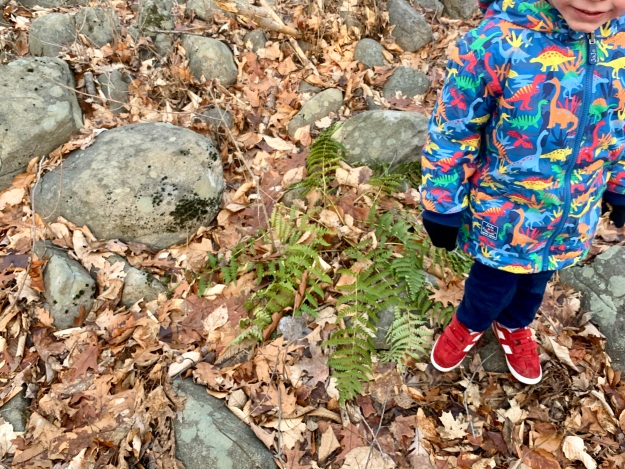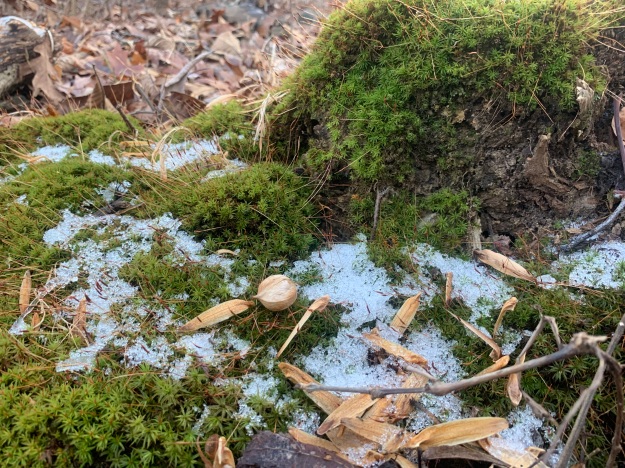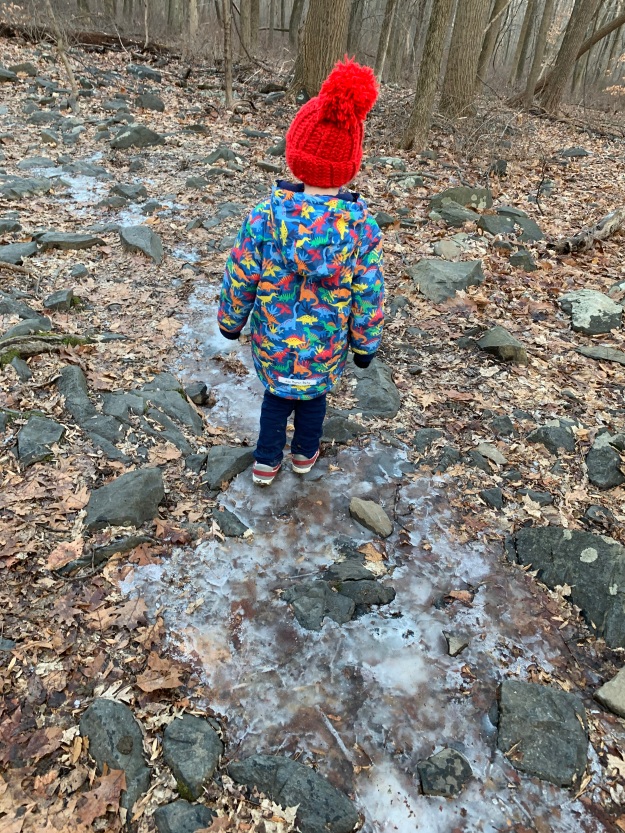The Somerset Sourland Mountain preserve is located on Mountain Rd in Hillsborough.

The Winter Solstice has come and gone and though it will still be cold, I am looking forward to the longer days. Life can be hectic this time of year with all the holidays and many people are so busy trying to clear their desks before the new year that it often seems that there is more work to accomplish than there are hours in the day.
I had to put the brakes on, slow down a bit and spend some time with my oldest. His budding independence is evident in his questions and desire to explore for himself. I decided to let him lead me on a hike through the woods. I asked him where he wanted to go and he said on a hike with “lots of rocks for climbing”. My first thought was of the Sourland Mountain Somerset County Preserve. There are also a lot of rocks for climbing at the Sourland Mountain Hunterdon County Preserve and I often take my Wild Boys there when I am hiking with them. The area is fairly flat, which makes it easier for me as the littlest will inevitably want to be carried. This time, however, it was only the two of us.
There were a lot of people in Somerset Preserve that day. I rarely see others while I am out on the other Sourland trails, and the Wild Boys are also not used to encountering other people while hiking. My oldest asked me what all the people were doing there. He thought that it was odd that no one was stopping to lift up logs, smash acorns or climb on rocks. A couple of times, he tried to show a passerby some of his discoveries just to have them say “oh, that’s nice” and keep on walking without pausing to take a look. My heart sunk at the disinterest of others. I told my son that many people come to walk in the woods in order to exercise and not to explore. We really enjoy exploring and we always go slow and take in the beauty and mystery with the anticipation of discovering something new that day.
Today’s hike was led by my oldest. He picked the trails, and told me what to take pictures of. I loved watching him explore and decide what needed to be photographed.

A Christmas fern, Polystichum acrostichoides, stood out on the mostly brown and gray landscape. My big dude ran right for it and pointed it out to me.

All of the boulders needed to be climbed!

Multiflora rose, Rosa multiflora, in fruit. When I asked my son what he thought this plant was, he said “Truffula seeds!”. The Lorax has been in regular rotation as a bedtime story in our house and he has been very passionate about planting trees and spreading seeds around so that the Lorax and the Brown Bar-ba-loots, Swomee swans and Humming fish will come back.

We found a hole in a tree! Anyone home?


Moss with seta and some spore capsules, Tulip poplar, Liriodendron tulipifera, samaras and a Hickory, Carya spp., nut. We loved touching all of the different plants and plant parts. They were soft, hard, crunchy, cold and wet.

This tree was so big that he couldn’t give it a proper hug.

This tree was just right.

A Winged Euonymus, Euonymus alatus. We felt along the branches and found that sometimes the “wings” come out on 4 sides of the branch and sometimes only on two sides.

Getting a really good look at the moss.


A boulder with “polka dots” aka Lichen!

We picked some Garlic Mustard, Alliaria petiolata, and sniffed it. I was informed that it was “peee-ew, stinky!”. As a side note, I was trying to look up the proper way of spelling what sounds like “P.U.”. Some linguists believe this arose from the latin word “puteo” which means “stink” or “rotten”. If you have any other ideas on where that phrase came from, let me know!

Checking for trolls under the bridge.

The cold crisp December air and the bright blue sky.

Ice needles! We were crunching along the frozen ground and accidentally kicked up a chunk of soil only to discover that it was not really soil but ice needles. We picked them up and turned them over observing all of the beautiful crystals that crunched satisfyingly under our feet. Ice needles are formed through a process called “Ice Segregation”. This process occurs when the soil is saturated with water (from all those rains we have been having!) and the temperature of the soil is above 0 degrees C and the air temperature above the soil is below 0 degrees C. Ice begins to form at the interface between soil and air, and through capillary action, pulls up water from the soil to form these little needles as the water freezes and expands. Read more about them here!

The “sitting tree”. This tree had a perfect trunk for sitting, thinking and getting a better view.

An empty Shagbark Hickory, Carya ovata, hull filled with ice crystals. We talked about how the the empty hull was like a little cup holding water that animals could drink from.

Breaking some Red Oak, Quercus rubra, acorns open with a rock (because we do not have teeth as sharp and as strong as a squirrel).

The inside of the acorn is white!

The mesmerizing layers of an acorn cap.

A really soft patch of moss growing in a crack in the rock.

The fruit of a Tulip Poplar, Liriodendron tulipifera. The fruiting body is comprised of many samaras. A samara is a nut or seed that has a wing or wings. Another example of a samara is the fruit of the maple tree.

I love listening to the rattle of marcescent leaves of the American Beech, Fagus grandifolia, as the wind rings them like chimes. My oldest asked why some of the trees still had leaves and others did not. I explained to him that some trees keep leaves on to help them stay warm in the winter. A deeper dive reveals that leaf marcescence occurs when a deciduous tree does not drop its leaves. This phenomenon occurs in quite a few species belonging to the Oak (Fagaceae) family. A marcescent leaf does not form an abscission zone at the petiole (the leaf’s base) and the twig it is attached to does not form a protective cork layer. Generally, in most deciduous trees, a hormone called “Auxin”, is sent out from the leaf to the tree saying “I’m working hard!” and the abscission zone does not develop. If the amount of Auxin decreases due to stress (drought, disease, injury) or lack of photosynthesis, the abscission zone will form and the leaf will drop off. It is not entirely clear why some trees exhibit marcesence and others do not, but it is more typical on younger trees. It is thought that these inactive leaves may protect from herbivory or protect young leaf buds from desiccation during the winter.

He asked me why people write all over the tree and if it hurt the tree. I often ask myself the same questions as to why people would carve their names into a tree. I told them that it was probably so that they would remember their time in the woods and that while it wasn’t good for the tree to be cut, it wasn’t going to harm the tree too badly as long as they don’t cut too deep.


Investigating the miniature waterfalls.


I love the dinosaurs!! What a lovely walk together!!
LikeLike
Thank you!
LikeLike
In the tree a hobbit house (?) — I feel the calm from your walk — thanks!
LikeLike
Elaine, I think you may be on to something! 😉
LikeLike
I loved reading this, and am so inspired by your son’s curiosity and your knowledge. thank you for sharing, and I wish I’d been there to admire what he found.
LikeLike
Thank you! Maybe one day we will meet on a trail!
LikeLike